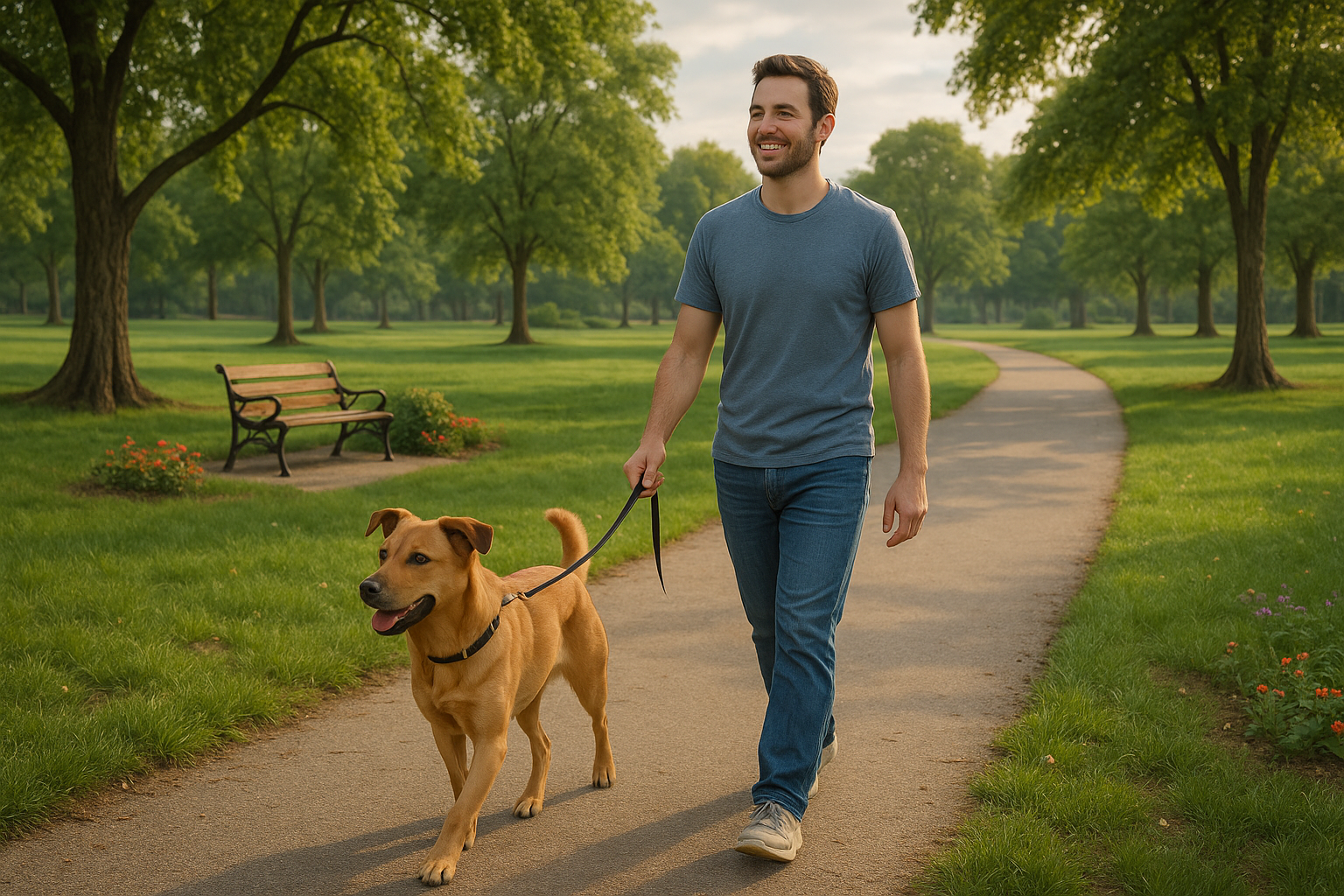You’ve got your favorite playlist on, the sun is shining, and everything seems perfect. Suddenly, your peaceful stroll turns into a battle of wills as your dog decides that he wants to pull you around every tree, fire hydrant, and squirrel that comes into view. The peaceful walk you envisioned quickly turns into an exercise in frustration for both you and your four-legged friend. 😣 Sounds familiar, doesn’t it? This common experience underscores the importance of leash etiquette – a skill that often remains underestimated in dog training.
🐕🦺 Leash etiquette, for those unfamiliar with the term, refers to the training and behavior that both the pet owner and their dog display when on a leash during walks. While it may seem like a simple enough concept, mastering leash etiquette is a process that requires patience, understanding, and consistency. This is why it’s important to understand the nuances behind it. When executed correctly, leash etiquette can transform the experience of walking your dog from a potentially frustrating tug-of-war to a pleasurable and bonding activity. 🐶💕
There’s no doubt that leash etiquette is a multi-faceted subject. It involves understanding your dog’s body language, reinforcing positive behavior, managing distractions, and establishing consistent commands. It’s not just about controlling your dog’s physical movements, but also about fostering a respectful and mutual understanding between you and your canine companion.🐾💬 So, where does one begin?
In this comprehensive guide, we will delve into the topic of leash etiquette and provide actionable steps that can help you and your furry friend enjoy more controlled and happier walks. We’ll discuss the basics of leash training, the significance of a structured walk, effective communication methods, and techniques to handle distractions. We’ll also highlight the importance of consistency and patience in the training process. By the end of this article, you’ll have a clear roadmap to mastering leash etiquette, thereby enhancing the quality of your walks and the relationship with your pet. 🏞️🐕
Before diving into the meat of the subject, let’s address one fundamental question: why is leash etiquette so important? 🤔 The answer is quite simple – a well-behaved dog on a leash is not just a reflection of good manners but also ensures safety. A dog that’s prone to pulling or lunging can pose a risk to himself and others around him, not to mention the potential strain on your arms and shoulders! Moreover, a dog that’s able to walk calmly by your side enhances your overall walking experience, promoting a sense of companionship and mutual respect. 🐶👫
On this journey to mastering leash etiquette, it’s essential to keep in mind that every dog is unique. They have their own personalities, quirks, and learning pace. As such, patience and understanding are your greatest allies. Like with any training, there will be good days and bad days. What’s important is to remain consistent, patient, and maintain a positive attitude. Remember, this is not just about training your dog, but also about strengthening the bond between you and your furry friend. 🐾💞
So, are you ready to take the leash and embark on this journey towards more enjoyable and controlled walks with your dog? Let’s dive right in and begin our exploration of leash etiquette. 🐕🦺🌳
Decoding Leash Etiquette: The Starting Point
Mastering leash etiquette is about teaching your furry friend manners, understanding their behaviour, and establishing a respectful relationship. The essence of leash etiquette is not about exerting control but about encouraging collaboration. As an owner, you have the responsibility of ensuring your pet’s safety during walks. More importantly, you must understand that your actions reflect on how your pet behaves.
Walking your dog can be a relaxing and enjoyable activity for both of you. But without a basic understanding of leash etiquette, it can quickly turn into a stressful and unproductive endeavor. Whether you’re dealing with a stubborn leash-puller or an overly excitable pup, a little bit of training and patience can go a long way.
Many people assume that leash training is difficult and time-consuming. But the truth is, it’s all about consistency and positive reinforcement. It’s about setting clear expectations and rewarding good behaviour. Before we dive deeper into the nuances of leash training, let’s take a look at why it’s so important.
The Importance of Leash Etiquette
Leash etiquette is about more than just making walks more enjoyable. It’s about safety, respect, and responsibility. Not only does proper leash behaviour keep your pet safe, but it also respects the space and peace of others in your community.
A dog that pulls on the leash can cause injuries to themselves and their owner. A sudden jerk can lead to strains or sprains, and constant pulling can cause more serious conditions like throat damage. It also sends a message to your dog that they are in control, which can lead to other behavioural problems.
Moreover, not everyone is comfortable around dogs. Some people may have allergies, fear, or just not appreciate a dog invading their personal space. A well-behaved dog on a leash shows consideration for those around you. For a detailed comparison of the effects of proper leash etiquette, see the table below:
| With Proper Leash Etiquette | Without Proper Leash Etiquette | |
|---|---|---|
| Safety | 👍 | 👎 |
| Respect for others | 👍 | 👎 |
| Controlled walks | 👍 | 👎 |
| Stress level | Low | High |
| Enjoyment | High | Low |
Understanding Your Dog’s Behavior
Before we dive into the techniques to improve your leash etiquette, it’s crucial to understand why your dog behaves the way they do. Is your dog pulling because they’re excited? Are they fearful? Or are they simply trying to establish dominance? Understanding the root cause of the behaviour is the first step in changing it.
One common reason for leash pulling is that your dog is just excited to explore their environment. They’re excited to smell new scents, see new sights, and perhaps meet other dogs. This is a natural behaviour that you should encourage, but within the bounds of safety and respect for others.
Another common reason is fear. Some dogs might pull on the leash because they’re anxious and trying to escape from a scary situation. In these cases, forcing your dog to confront their fear is not helpful. Instead, you should try to understand what’s causing the fear and work on desensitizing them to it.
Practical Techniques for Better Leash Etiquette
Now that we understand the importance of leash etiquette and why dogs behave the way they do, let’s look at some practical techniques to improve leash behaviour.
First and foremost, you should start by choosing the right equipment. A sturdy, comfortable leash and harness are crucial. Avoid retractable leashes as they encourage pulling and can be dangerous. Instead, opt for a fixed-length leash that gives you better control. The video from Zak George’s Dog Training Revolution provides a comprehensive guide on choosing the right leash and harness for your dog.
Training your dog to walk nicely on a leash requires patience and consistency. Start by practicing in a quiet, distraction-free environment. Hold the leash loosely and let your dog explore within the leash’s length. If your dog pulls, stop in your tracks. Only start moving again when your dog stops pulling and the leash slackens. This technique teaches your dog that pulling will not get them where they want to go.
The Power of Positive Reinforcement
Positive reinforcement is a powerful tool in dog training. It’s based on the idea that dogs will repeat behaviour that is rewarded. So, if your dog walks nicely on a leash, make sure to reward them with treats, praise, or play.
Remember that the reward should be immediate so that your dog associates the good behaviour with the reward. Be consistent with your rewards and use them to reinforce good behaviour throughout the day. For instance, if your dog stays calm when another dog passes by, reward them immediately.
Apart from treats, you can also use toys or a favourite game as a reward. Some dogs might be more motivated by play than food. The key is to find what motivates your dog the most and use it to reinforce good behaviour. For more information on using positive reinforcement in dog training, check out this video by The Dog Training Secret.
Conclusion: Mastering Leash Etiquette Takes Time and Patience
Mastering leash etiquette is not something that can be achieved overnight. It requires patience, consistency, and a solid understanding of your dog’s behaviour. But with time and practice, you and your furry friend can enjoy peaceful, controlled walks.
Remember, it’s not about establishing dominance or control over your dog. It’s about teaching them manners and ensuring their safety. It’s about respect – for your dog, for you, and for the community you live in.
So, take the time to understand your dog’s behaviour and needs. Use positive reinforcement to encourage good behaviour. And most importantly, be patient and consistent. Your efforts will pay off in the end, leading to happy and controlled walks with your furry friend.

Conclusion
In conclusion, we have traversed the vast landscape of software engineering and technical writing, diving deep into the core aspects of these crucial fields. We began with the understanding that software engineering is not just about coding but involves a thorough understanding of systems, architecture, and design patterns. It is a discipline that combines creativity with precision, calling for an in-depth knowledge of programming languages and the ability to solve complex problems.
We then moved to the realm of technical writing, a skill equally pivotal in the IT and engineering industries. Clear and concise communication is key in the world of technology, making technical writing an indispensable tool. This skill bridges the gap between highly technical information and the end-user, ensuring that the technology can be used effectively.
Let’s recap some of the salient points we covered:
– The essence of software engineering, its methodology, and the role it plays in creating effective software solutions.
– The significance of technical writing in translating complex technical information into comprehensible language.
– How these two skill sets overlap and how they can be used in conjunction to optimize results.
One thing remains clear: whether you are a software engineer or a technical writer, or even someone interested in these fields, mastery in these areas is a valuable asset. The ability to understand complex technology and communicate it in a simple, understandable manner is a rare combination that can propel your career and add value to any team.
The importance of these skills can’t be overstated in today’s digital era, where technology is at the forefront of every industry. The more we understand, the better we can utilize and optimize the technology that surrounds us.
I hope this article has shed light on these key areas and inspired you to delve deeper into the world of software engineering and technical writing. Perhaps you might even consider expanding your skills or exploring a career in these fields.
Feel free to share this article with others who might find it beneficial. Your comments and feedback are also welcome, as they can enrich the discussion and provide different perspectives on the topic.
For those interested in further study, here are some active research links:
– Software Engineering Technical Committee
– Society for Technical Communication
Knowledge, after all, is a continuous journey, and every step we take in learning brings us closer to understanding the complex world around us.
Let’s keep the conversation going, delve into these subjects, and continue to grow together. 👩💻👨💻
#SoftwareEngineering #TechnicalWriting
Remember, the more we share, the more we have. So, don’t hesitate to share your thoughts or experiences. The comment section is just a click away. 🗨️
Stay tuned for more insightful articles. 📘👍
Until then, happy coding and happy writing! 🎉



